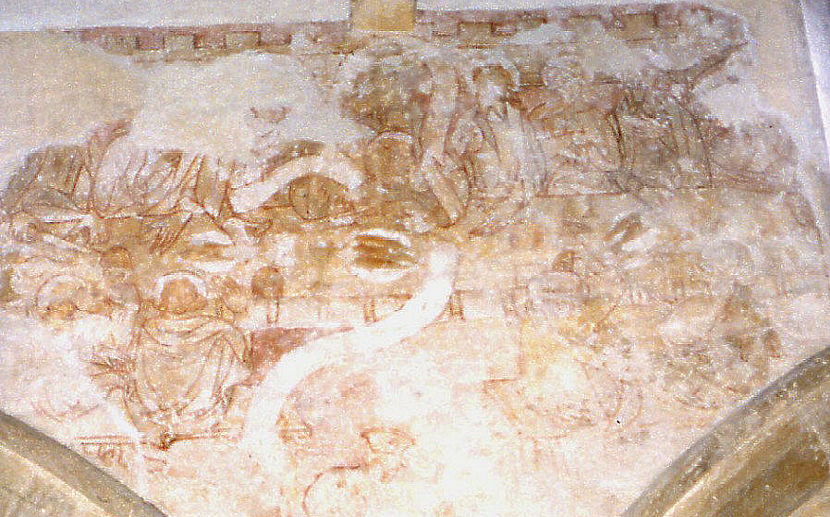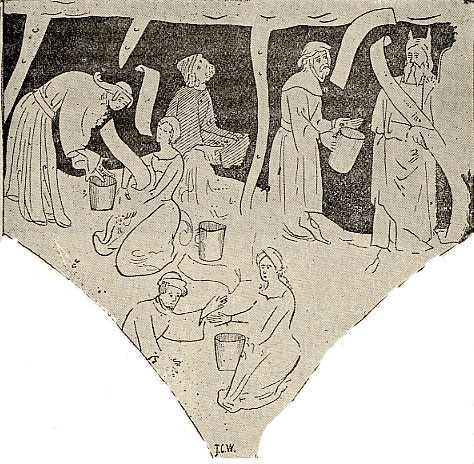Friskney, Lincolnshire (†Lincoln) c.1320
The Last Supper
This Last Supper is part of a typological scheme. Its counterpart from the Jewish Bible, Manna in the Wilderness, is no longer visible, but JC Wall’s pre-1925 drawing of it is reproduced at the bottom of this page. (There is brief discussion of typology in general and this pairing in particular in the Introduction to Genesis scenes).

Faded as it is, this is a very interesting example of the subject, with disciples sitting on both sides of the rectangular table. It is possible (though difficult) to make out 12 and perhaps all 13 people here.
Christ sits in the centre of the table at the far side, directly below the end of the roof beam shown in the picture. He is not much more than a suggestion of a figure now, but the speech-scroll looping around his head may help to locate him. Below the head and shoulders of Christ is a rounded, haloed shape which is I think Peter, literally ‘lying on Jesus’s breast’¹. To the left of Peter is another, shorter, speech-scroll. There seem to be six more disciples on this side of the table, three of them on either side of Christ and Peter in the centre. I think the one with a forked beard immediately to the right of Christ is probably Andrew – who is often shown thus bearded and in this position of honour. He has his right hand raised in consternation, I think.

Sitting on the other side of the table, their backs to us, are four more disciples, the one second from the left clearest and showing skilfully painted draperies. Snaking across the table from Christ, in what must originally have been a very dramatic fashion, is another speech-scroll, curving around the central platter with three fish (there are at least two more, with two fish each), and ending beside confused remnants which suggest another figure, but one apparently not seated like the others. This, I think, must be Judas, quite possibly at the moment when he ‘went immediately out’ as narrated in John 13:30.
In fact the whole painting seems to be an illustration of the central verses of John 13 which, with its high drama of the giving of the sop and Judas’s departure, perhaps appealed to painters – especially those for whom didacticism was important² – more than any other Gospel account of the Last Supper. The speech-scrolls would almost certainly once have been inscribed with quotations from it.
Manna in the Wilderness³, at the left, shows the Israelites gathering Manna, with Moses, the traditional horns on his head*, looking on at the upper right. He was originally holding the Tables of the Law in his left hand.
¹ If this was Peter and not in fact John (the disciple whom Jesus loved). The text is ambiguous here.
² For example Lucas Cranach the Elder, in his Wittenberg Altarpiece, 1549 [Wittenberg City Church, Germany]
³ Illustration in JC Wall, Medieval Wall Paintings, n.d. (before 1925), Talbot & Co, London, p.91 (see note on the page for Hauxton. The same applies to copyright in this case.
* These horns, the result of a mistranslation of the Exodus text describing Moses’s appearance when he came down from Sinai, persisted well into the 16th century. Holbein’s woodcuts include them, and so does Michelangelo’s Moses (sculpted figure, tomb of Pope Julius II).